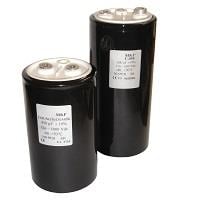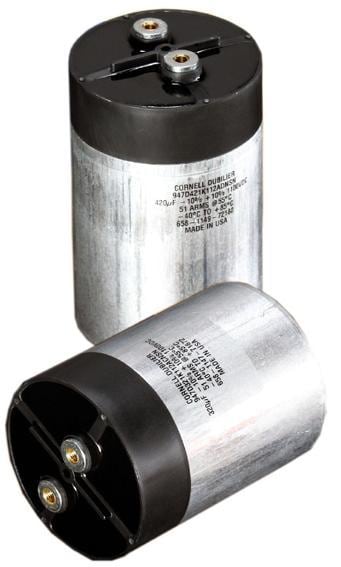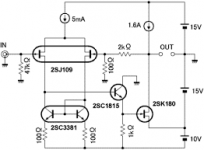1000uf MKP caps
mr.pass have mention this caps at deLite article:
"The output capacitor C3 protects the speaker from the DC voltage
seen at the Drain pin of the Mosfet. If your speaker drivers are capacitively
coupled already by a crossover filter, you might eliminate this capacitor, and of
course you can use a better capacitor than my 10,000 uF 50V electrolytic.
1,000 uF of polypropylene capacitance will get you down to around 30 Hz or so,
and larger values will get you lower, if you can afford them."
i saw this caps are available at mouser,
have anyone ever tried this big 1000uf - 2000uf MKP caps for output?
thanks.


mr.pass have mention this caps at deLite article:
"The output capacitor C3 protects the speaker from the DC voltage
seen at the Drain pin of the Mosfet. If your speaker drivers are capacitively
coupled already by a crossover filter, you might eliminate this capacitor, and of
course you can use a better capacitor than my 10,000 uF 50V electrolytic.
1,000 uF of polypropylene capacitance will get you down to around 30 Hz or so,
and larger values will get you lower, if you can afford them."
i saw this caps are available at mouser,
have anyone ever tried this big 1000uf - 2000uf MKP caps for output?
thanks.


Last edited:
Me 
I use one 1uf for my tweeter driver and 2x 470uf ( one big can MKP and one small stacked film)
for the full range driver.
I prefer this output config than a 10000uf rifa phe200.
I use one 1uf for my tweeter driver and 2x 470uf ( one big can MKP and one small stacked film)
for the full range driver.
I prefer this output config than a 10000uf rifa phe200.
An externally hosted image should be here but it was not working when we last tested it.
Last edited:
Me
I use one 1uf for my tweeter driver and 2x 470uf ( one big can MKP and one small stacked film)
for the full range driver.
I prefer this output config than a 10000uf rifa phe200.
whoa... that big clarity caps are beautiful
thanks, at least that's convinced me to buy those big caps because it's so expensive
btw is this caps good for low freq or high freq? (from your experience)
I have a question about the 2sk180. Just how hard is it to drive that beast ?
I think I read both Nelson and Michael Rothacher mention it might be hard
to drive because of the high input capacitance of about 2,500 pf ? . But this
device has a very low mu so wouldn't that minimize the miller capacitance ?
So today I hooked one up and as Mr. Rothacher said " Huston we have amplification "
My scope is acting up so I just used a tweeter to check the high frequency output
and while using a 10k input signal once with just the signal generator and then
with a 10k resistor in seriese with the signal generator it seemed I was only about 6 db down using that whopping 10k resistor in series with the signal generator. I was expecting a lot more high frequency roal off. What am I missing ?
I think I read both Nelson and Michael Rothacher mention it might be hard
to drive because of the high input capacitance of about 2,500 pf ? . But this
device has a very low mu so wouldn't that minimize the miller capacitance ?
So today I hooked one up and as Mr. Rothacher said " Huston we have amplification "
My scope is acting up so I just used a tweeter to check the high frequency output
and while using a 10k input signal once with just the signal generator and then
with a 10k resistor in seriese with the signal generator it seemed I was only about 6 db down using that whopping 10k resistor in series with the signal generator. I was expecting a lot more high frequency roal off. What am I missing ?
watch this: Papalecture at BAF 2015
thanks Zm i almost forget the CCS/MU output trick , i have tried it with the l'AMP CCS and split the 1R resistor under the IXTH6N50D2 in two 0.47R and plug my output cap on the middle. the amp seems more powerfull like this ; sound goods too
thanks Zm i almost forget the CCS/MU output trick , i have tried it with the l'AMP CCS and split the 1R resistor under the IXTH6N50D2 in two 0.47R and plug my output cap on the middle. the amp seems more powerfull like this ; sound goods too
Interesting!
Last edited:
Hello,
I have used them a lot but whenever possible i will not try to depend on the glue entirely ( even if they say glue is used for aeroplanes) and use one or two screws as well. Especially if parts are a bit heavy. In the original photo the parts is kind of hanging in between two connections. There it is just an extra safety.
Better be safe than sorry.
Greetings, Eduard
thanks Zm i almost forget the CCS/MU output trick , i have tried it with the l'AMP CCS and split the 1R resistor under the IXTH6N50D2 in two 0.47R and plug my output cap on the middle. the amp seems more powerfull like this ; sound goods too
I used an array of ohmite .5-.25-.25 under the ixys dmos in mine. Playing with the various taps I observed that tapping closer to the ixys yielded a more holographic "vfet sound" (big staging... drum kit is in front of the singer!) at the expense of lower freq power, while tapping further away flattened the soundstage, but with better bass. to wit, the furthest tap had the least "vfet sound" and closer toward that of a regular mosfet. Definitely a sweetspot thing, varying mileage. It would be nice to have the test equipment to see what is happening but I'm just a constructor.
- Home
- Amplifiers
- Pass Labs
- L'Amp: A simple SIT Amp

